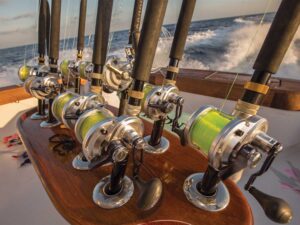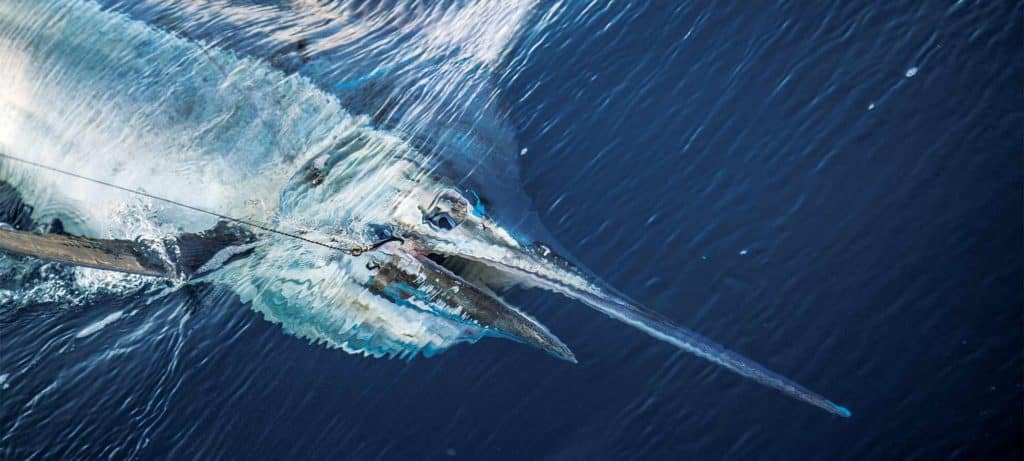
When Bart Miller died in 2018, he left behind a rich legacy as one of the sport’s most well-known fishermen-turned-lure-designers. His line of Black Bart lures has become the gold standard around the world for their ability to raise and catch marlin. Miller’s friends and longtime business partners, Jack Tullius and his brother Gary, continue that legacy as the current owners of Black Bart Lures.

And yet for all the popularity of artificial lures, natural bait remains a top choice in many areas of the fishing world. Mark Pumo grew up fishing off Miami and the Bahamas. He started fishing some of the local billfish tournaments after college, where he noticed a need for high-quality natural baits. His team at Baitmasters of South Florida has become one of the sport’s top bait suppliers. If you’re pulling a ballyhoo, Spanish mackerel, mullet or squid in your spread, there is a pretty good chance it arrived to you in one of those distinctive yellow-and-black Baitmasters packs.
To help better understand the specific benefits inherent to artificial lures and natural baits, we looked at a number of critical parameters. This is a head-to-head comparison: bait versus Bart.
Billfish Species
This is perhaps the most important factor to consider. If you’re chasing only blue or black marlin, then a spread of large, active lures fished on heavy tackle is hard to beat.
“Lures give you the ability to cover water at higher speeds, with the size and fish-raising action you need to get the attention of an apex predator like a marlin,” Jack Tullius says. “While elephants do eat peanuts, big fish usually prefer to hunt and consume large prey items that are worth the energy they expend to chase them down.”
However, if the target species include white marlin, sailfish and game fish, then bait may be a better choice. White marlin are especially notorious for their ability to whack even a small lure multiple times without finding the hook. In this case, a spread of chin-weighted ballyhoo fished on circle hooks is a much better option.
From Southern California down to Cabo San Lucas, Mexico, teams pull artificial lures for striped marlin, but they almost always have a pitch bait ready, often a live or fresh-dead caballito already bridled and ready to go. If the marlin doesn’t hook up immediately, the bait is introduced to entice the fired-up stripey to switch over. It’s a tactic that allows the boat to cover territory as the crew searches for fish on the surface, while greatly improving their hookup ratio once they do raise a marlin.
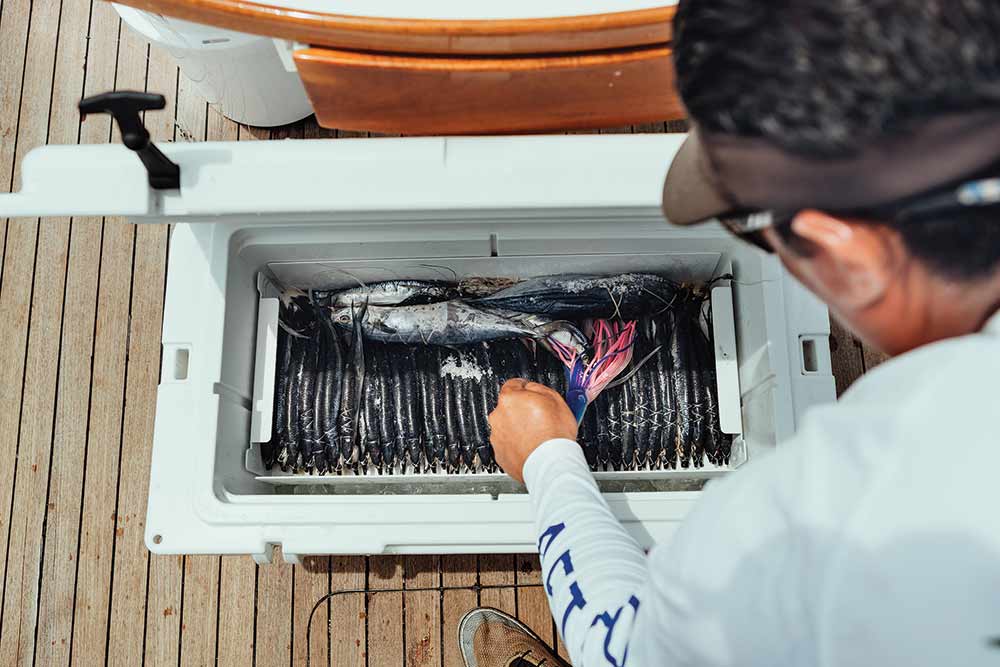
Destination
Where you fish has almost as much importance as the target species, and the two are certainly related. Specific locations in the world are almost exclusively dead-bait-centric locales, while others are the hallowed halls of lure fishing. In Central America, the dead-bait ballyhoo spread is the bread and butter of the charter-boat and tournament crews, just as it is throughout the Carolinas and Florida. But venture to Bermuda or Hawaii, and the name of the game is lure fishing. This isn’t to say there is not some crossover: The Costa Rica captains will occasionally pull lures at the seamounts for blue marlin, and the smart Bermuda captains will have a pitch bait ready for a white marlin on the Challenger Bank, but in general, the destination will often dictate the tactics on the water.
“It has been said that you pull bait to fly flags and fish lures to cash checks, and there is some truth to that bit of dockside philosophy.”
Release or Kill
It has been said that you pull bait to fly flags and fish lures to cash checks, and there is some truth to that bit of dockside philosophy. If the goal is to pile up billfish releases in a tournament, it’s hard to beat a dead-bait spread. With circle hooks, most fish will be hooked in the corner of the jaw, and it’s much easier to hook and quickly release double- and tripleheaders of sailfish or white marlin on bait. But if only the largest blue or black on the dock wins the Happy Gilmore-size check, a big hunk of skirted resin is almost always a better bet.
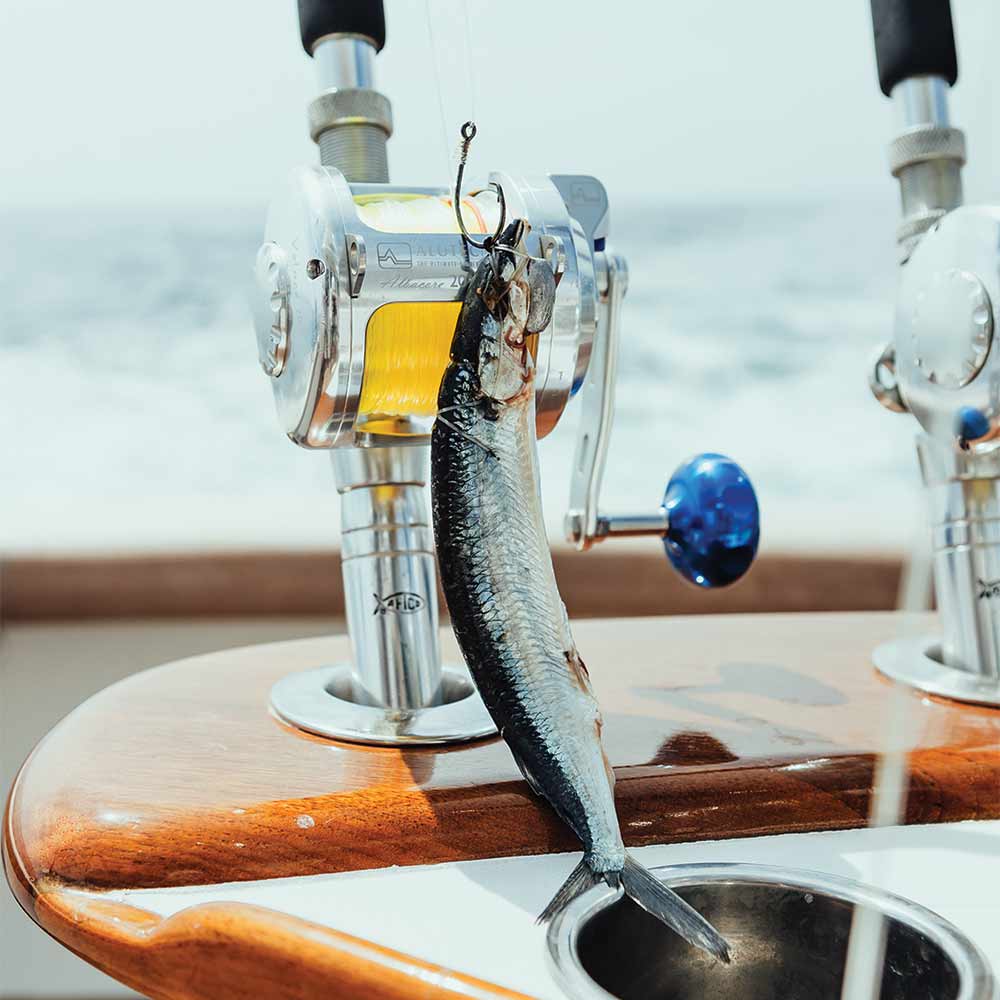
Skill Level
While it does take experience and skill to become a really good lure fisherman, it’s also much easier for a relatively inexperienced team to start catching fish with lures (and a spread of five Black Barts fished at 8 knots is a pretty good start). Dead bait requires a higher level of skill, starting with the preparation. “Poor bait prep and sloppy rigging techniques mean that the bait will wash out quickly and not swim correctly,” Pumo says. “It takes dedication and lots of practice to gain proficiency as a dead-bait fisherman, but it’s also a great source of pride for those who achieve that level of ability.” Pumo also notes that Baitmasters offers expertly prepared, pre-rigged natural baits for those who may not have the time or experience to rig their own.
Availability, Storage and Refrigeration
The availability of high-quality natural bait in certain parts of the world is a big issue, often forcing teams to ship large quantities of frozen bait to a destination well ahead of time. Sometimes this isn’t an option, especially when overzealous customs officials become involved. I’ve even seen cases where ballyhoo is considered frozen food, even after we pointed out that it’s clearly labeled as bait on the package. On the other hand, it’s easy to pack a full spread of plugs in a soft-sided lure bag and take them with you anywhere in the world.
“Natural bait also requires storage and refrigeration/freezer space, either on the boat or elsewhere,” Pumo says. “It has to be kept frozen solid until it’s ready to be rigged, and natural bait doesn’t last long once it’s thawed. Once the baits are rigged, they need to be kept cold but not in direct contact with fresh water or ice, which means a separate bait cooler or storage area on the boat.” Lures, of course, require no special treatment.
Time
Do you or your crew have the time to properly rig a full box of natural baits, or do you want to hop on the boat and go fishing? Rigging ballyhoo or mackerel is a process that involves carefully thawing, prepping and rigging dozens of baits, and it requires a host of miscellaneous small items like chin weights, waxed floss, O-rings or swivels, copper wire, rigging needles and more. Meanwhile, the same lures you pulled yesterday are ready to go today. Just check those hooks for sharpness, snap the leaders in the swivels and you’re all set.
J Hook versus Circle Hook
One main disadvantage of lures over bait is in the release ratio. Most lure fishermen will say that if they can maintain a hookup-to-release ratio of 70 percent or so, then that’s doing pretty well. Some boast of much higher percentages, but then again, there are also plenty of stories of rubber-hook days where teams are zero-for-4 on blue marlin, where the fish is hooked and pulling drag but manages to elude capture during the fight for whatever reason.
Circle hooks, on the other hand, have a much higher percentage of hookup to release, thanks to their shape, which catches the fish in the corner of the jaw. “For a hard-jumping blue marlin, they can throw that J hook fairly easily, while they have a much harder time shedding a circle hook during the fight,” Pumo says.
Interestingly, the mandated shift to circle hooks with natural bait, enforced by the National Marine Fisheries Service, caused a complete shift in North Carolina’s tournament blue marlin fishery. The standard Carolina marlin bait — a horse ballyhoo rigged on a J hook and fished in combination with a blue-and-white Ilander lure — was now illegal in tournament competition. Teams quickly learned to lure fish for big blues, while maintaining their prowess at dead-bait fishing for white marlin, yellowfin tuna and other species.
“Much like a cat chasing a toy, a blue or black will sometimes bat a lure repeatedly in an attempt to catch, kill and eat it, often resulting in some spectacularly unsuccessful bites.”
Action versus Taste
Lures are great at raising fish and getting bites, but it’s hard to beat natural bait in getting a marlin to actually eat the damned thing. Much like a cat chasing a toy, a blue or black will sometimes bat a lure repeatedly in an attempt to catch, kill and eat it, often resulting in some spectacularly unsuccessful bites. If you free-spool the lure, it loses its action and the fish quickly loses interest. With a ballyhoo or mackerel, a short drop-back gives the marlin a chance to grab it, and since it looks and tastes real, they can turn and swallow it easily. And while they don’t chug and splash like lures, it’s hard to beat the realistic swimming action of a well-rigged mackerel, mullet or ballyhoo in the spread. This one’s a draw.
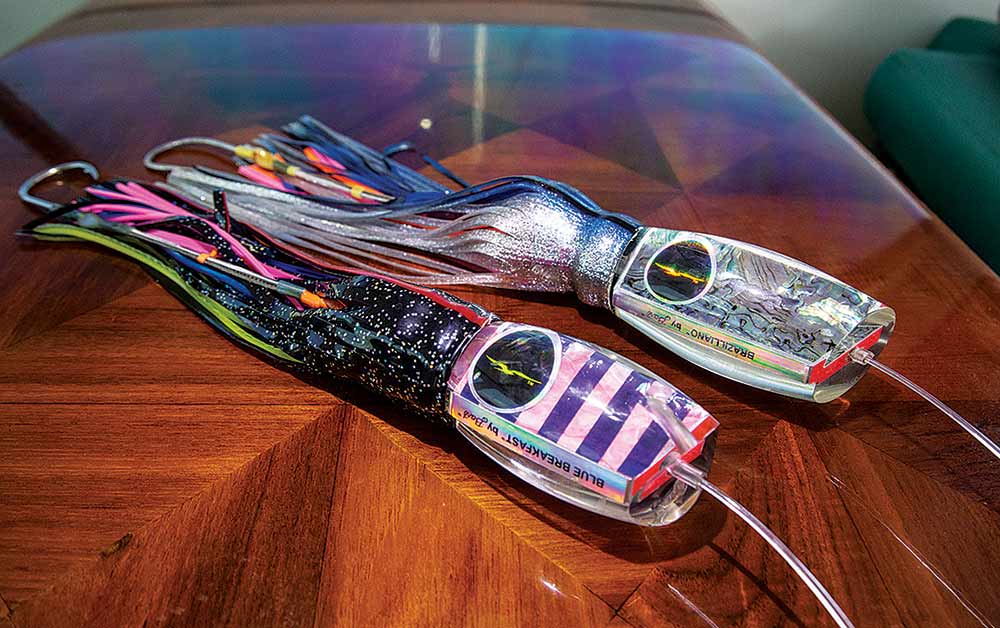
Teasers
Because of their fish-raising splash, color and shimmy, lures are a terrific option as teasers. Many a marlin has been raised to a Black Bart fished as a teaser before either being switched over to a pitch bait or hooked on a lure in the spread. On the other hand, a squid daisy chain with a ballyhoo chase bait is standard in just about any big-game fishery in the world. Having that natural bait gives the fish a taste of the real thing and keeps it engaged for those crucial few seconds needed to get a pitch bait in the water.
Read Next: 10 Best Marlin Lures
Weather
When the seas kick up, it becomes more difficult for both styles to perform correctly. Lure positioning on each wave is critical for them to swim rather than tumble and spin off the face or back. On the other hand, dead baits tend to get blown across the spread in a crosswind or when trolling in the trough, and each bait will probably need a bit larger weight to get it swimming beneath the whitecaps rather than skipping through them. Australia’s Great Barrier Reef, one of the world’s best-known rough-water marlin destinations, is home to some of the finest dead-bait marlin fishermen in the world, but lures are also right at home in places like Brazil and Cape Verde when the wind and seas howl and roar.
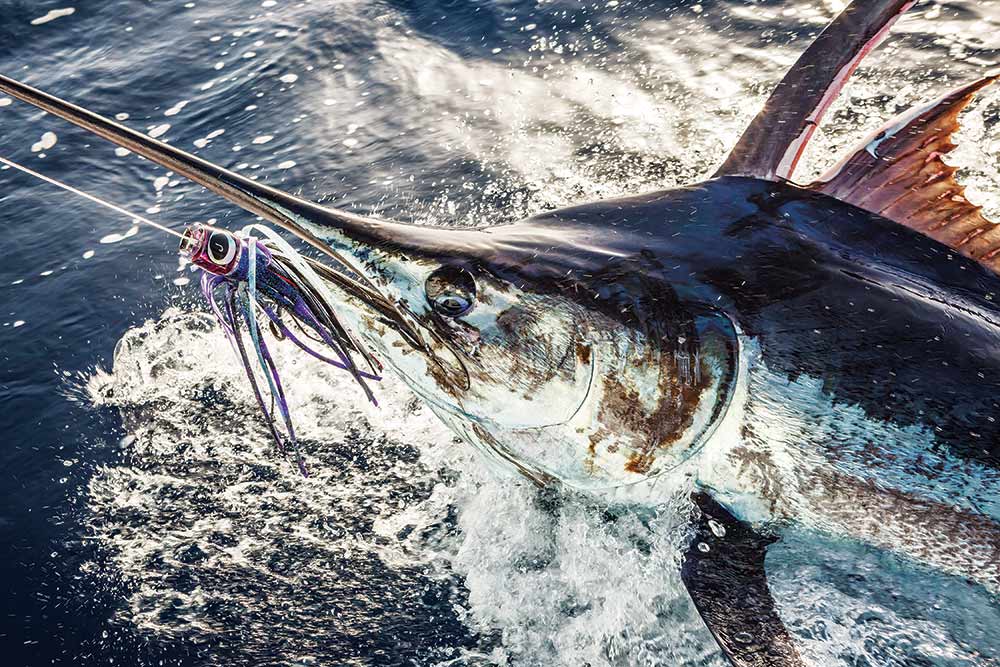
Chasing World Records
If you’re looking for an IGFA-record billfish, the choice between bait and lures will be based on the line class. The unlimited all-tackle and heavy-tackle blue marlin will almost always be targeted with lures, while the lighter line classes remain the near-exclusive domain of bait fishermen (although their marlin are almost always raised using a spread of artificial lures as teasers). Natural baits have much less drag in the water and are more easily swallowed by a hungry billfish, perfect for light-tackle fishing. But ask any big-marlin enthusiast, and they’ll say the world’s heftiest blues will be caught on big, splashy, flashy lures like the Black Bart Breakfast series.
“The beauty of fishing is that there is really no right or wrong, but there are some methods that have proved to be more effective than others,” Tullius says. “The most important thing is that you have confidence in what you’re presenting and pay attention to the small details.”
Natural bait is no better or worse than a full spread of artificial lures, but depending on the factors of species, location, availability, hookup-to-release ratio and more, it’s easy to choose which technique will produce more bites.
